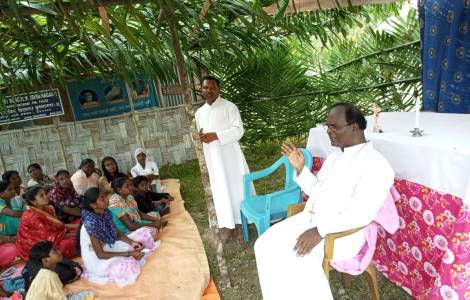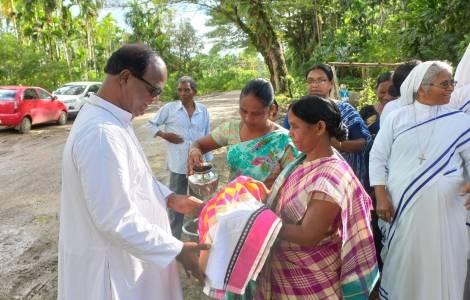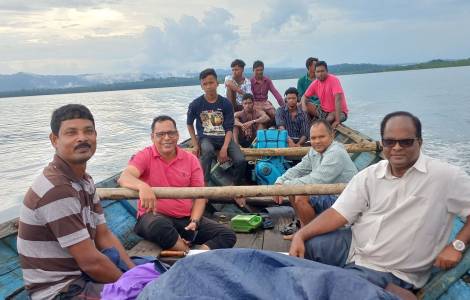ASIA/INDIA – Between villages and “marine mission stations”, the journey of the Church synod in the Andaman and Nicobar Islands
Port Blair (Agenzia Fides) – The Andaman and Nicobar Islands, in the Indian Ocean, is a Catholic community that has lived the synodal style since its birth. The only diocese that covers the entire region, Port Blair, has 500 islands, 40 of which are inhabited, with a presence of around 40,000 Catholics, out of a population of nearly 500,000, mostly Hindus, plus some animists and Islamic groups. To overcome the risk of isolation, the local Church is clearly called to “walk together” as a community and provide, with everyone’s contribution, for the needs of the Church, starting with the livelihood of the staff and members of the ecclesiastical structure. As is often the case in dioceses spread across the archipelago, priests, religious and catechists also have to travel long distances to reach the most remote parishes and villages. “Already on South Andaman Island, where Port Blair is located, it takes up to two days to get to the north of the same island,” explained Agenzia Fides Mgr Visuvasam Selvaraj. “The most widely used method is by boat, but with different stops, the journey can take longer,” he added with a smile.
In the diocese of 18 parishes spread across the island, 51 priests work (9 diocesan priests, the same number of religious priests) but in many villages, all fishing villages, there are often small chapels, more than 150 in total, real “marine missionaries” . station”, where several families of the baptized people gathered. The islands were evangelized by Belgian Jesuit missionaries who arrived in the early 1900s from northern India: “Taking into account the fragmented reality of the islands, the missionaries took great care, from the beginning, to create a system in which the laity participate fully in it. They borrowed “democratic” practices and ways of community management from tribal communities, especially those from the Chhota Nagpur region, in the present-day states of Jharkhand and Chhattisgarh. “before the Second Vatican Council, the participation of the laity in the life of the Church in the Andamans was very extensive, even at the level of responsibility,” the bishop said.
This specificity, which characterizes the life of the local Church, facilitates participation in the work of the Synod organized by the Holy See, thanks to the full involvement of the community: “We held consultations in 18 parishes, explained “the bishop, and in 90% of the 159 villages of the diocese, the faithful participate in dialogue and discussion. The life of our Church is divided into many small communities. There are 552 small Christian communities that live their faith as a gift and responsibility. This also means massive participation in the practice of faith: more than 70% of baptized people go to church regularly on Sundays.
The synodal approach usually applies in pastoral life, “where the bishop is not ‘one man in charge’, but always listens to the community because the Holy Spirit manifests himself in the community”, he stressed. This is, according to the Port Blair pastor, “the secret to having a community that walks joyfully toward the Kingdom of God. We live, by God’s grace, a spirit of unity between priests, religious, lay organizations. The structural condition of the Church is spread among distant communities, there is a strong intention to unite, work together, and be in solidarity. This is a gift that we can witness in society. This is also felt in the financial support given to the Church. “The monthly offering is determined by God’s people, who responsibly take care of the needs of each parish. Bishops and priests live a simple lifestyle. We try to be close to the people,” he said. And he related his experience: “As a bishop, for example, I visited in two years, traveling continuously, a total of 89 villages, even small ones, with ten Catholic families in each. I spend 24 hours with them, I visit family, I listen, I share, I administer the sacraments. I eat with them, I celebrate Mass. This sharing is greatly appreciated by the faithful. Moreover, my diocese is open to everyone. Everyone can come and talk, the door is open. And the believers know it.
Bishop Visuvasam Selvaraj concluded: “Harmony reigns in the community. I can say, with joy and gratitude, that we are a happy community, a community that lives out its faith and bears witness to God’s love. As the Bible says: “You will be known by the love you have for one another.” Therefore, brotherly love is a form of evangelization and missionary in nature.”
In the early 1900s, the Andaman and Nicobar Islands were British territory which was also used as a place of detention. It was then that the first visits of Jesuits from Calcutta and missionaries from the Burmese region began. After India’s independence (1947), Catholic missionaries from Ranchi (now the seat of the Metropolitan Archdiocese) began traveling to the Andaman Islands. In 1965, the mission in the archipelago was entrusted to the Missionary Society of Saint Francis Xavier (SFX), the “Father of the Pilar”, based in Goa. The Diocese of Port Blair was established in 1985. Administratively, the islands constitute a Union Territory of India, an administrative division under the federal government.
(PA) (Agenzia Fides 30/9/2023)
Share:

“Twitter junkie. Hipster-friendly bacon expert. Beer ninja. Reader. Communicator. Explorer. Passionate alcohol geek.”









